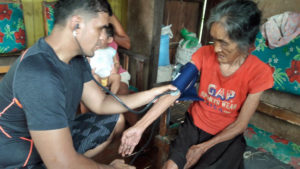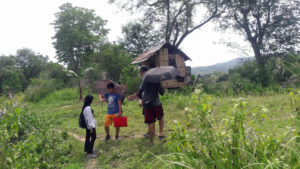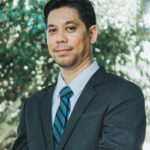Partnering Community Medicine and Biomedical Engineering – Melding Social Justice-Based Health Intervention and Technology for Peace and Development: An Ateneo de Zamboanga University Initiative
Afdal B. Kunting, MD, MPH, FPCP, Ateneo de Zamboanga University- School of Medicine and College of Biomedical Engineering
The Ateneo De Zamboanga University (AdZU) has a long and rich history of social justice. The concept of social Justice has been evident in the activities and programs of ADZU long before the term became fashionable. The School of Medicine (SOM) is one of the university’s flagship programs that continually uphold its social justice mandate. The SOM opened in 1994 with one of the most innovative medical education programs in the Philippines. Aside from using Problem Based Learning (PBL) as its mode of teaching, the school also engaged in the longest community immersion in the country. Students spend half of their medical education in rural and underserved communities in the region. This extended immersion allows the development of long term Community Health Plans (CHPs) together with an engaged community. This approach of community engagement is central to the concept of social justice that the ADZU advocates. This approach welcomes the community’s concept of health needs and priorities and enables students to tap into the vast local knowledge and cultural experiences in the conduct of activities. This also gives the community a sense of ownership of the CHPs and helps in long term implementation and sustainability

Students from Ateneo de Zamboanga School of Medicine doing rural community outreach in Mindanao, the Philippines
. The SOM methodology is a departure from the usual top-down planning activities formulated by local government units (LGUs) and health personnel which do not reflect the felt needs of the people. Another key concept being applied by the SOM is the use of inter-sectoral collaboration especially with traditional allies such as teachers, social workers, agriculturists, and security forces to name a few. These approaches increase the number of people working for the project and maximize the limited resources available in the community.
While the SOM has been successful in addressing some of these social realities, there are still many enduring problems. Getting current and complete data from the community has been difficult. Access to safe water remains a challenge while sanitation and poor waste disposal still contribute to disease burden. It seems that the SOM approach is inadequate to address some of the social determinants of health. How can these issues be addressed? Perhaps partnering with non-traditional allies and the use of technology and engineering can be a potential solution?
With the hope of addressing these gaps, in 2018, the AdZU together with its College of Biomedical Engineering offered the Bachelor of Science in Biomedical Engineering (BSBME) program. Similar to that of the SOM, the BSBME also apply a community immersion approach to its program. The students are partnered with medical students from SOM and assigned to an underserved community where they work together to identify challenges and develop Community Health Plans (CHP) that can be addressed with biomedical engineering solutions or regular engineering concepts. After a year of exposure, potential solutions include health kiosks that will collect demographic and health-related data, locally produced carbon-based water filters. and low-cost biogas reactors that students have produced.

Social justice-based interventions combined with technology brought to rural and underserved areas of the region restore a sense of hope to the population. It is a well-known fact that one of the drivers of secessionist or separatist movements is the sense of hopelessness among marginalized youth. The intervention seeks to assist and stimulate community-based initiatives and become a catalyst for development.
This collaborative learning method is a process of working together down to the community level that allows everyone to contribute to addressing the social determinants of health. The comprehensive way of looking at the problems in the community areas can provide direction on how to create a more enabling environment for the people to co-create. Ensuring that people are empowered in the health programs by formulating and implementing policies, in planning, developing, designing and making technology readily available to the poorest segment of society to achieve change and eventually lead to contribute and strengthen the peace and development of Zamboanga Peninsula.
Author details:
 Dr. Kunting is one of the earliest graduates of the Ateneo de Zamboanga University School of Medicine. He has worked for nearly a decade in the field of public health, working first as a Municipal Health Officer in the Municipality of Sergio Osmena and then a District Health Officer of the City of Zamboanga. He finished his Internal Medicine Residency at the Zamboanga City Medical Center with an elective on Heart Failure at the Foothills Medical Center in Alberta Canada.He has been a faculty of the ADZU-SOM since passing his licensure examination in 2000. He was initially a community preceptor then later Associate Dean for Community Affairs. He is currently part of the Research Committee of the school. He was part of several school programs to include the development of the community medicine component of the Family Medicine Specialist Program of the Faculty of Health Sciences, National University of Laos. He was also the organizer of the Rural Area Medicine Philippines (RAMP), a training program for rural physicians similar to the Rural and Remote Medicine Course of the Society of Rural Physicians of Canada. He is a pioneer faculty of the College of Biomedical Engineering (BME). He supervises the community exposure of the BME students and teaches the course on Anatomy, Physiology, Medical Devices and Gadgets for Engineers.
Dr. Kunting is one of the earliest graduates of the Ateneo de Zamboanga University School of Medicine. He has worked for nearly a decade in the field of public health, working first as a Municipal Health Officer in the Municipality of Sergio Osmena and then a District Health Officer of the City of Zamboanga. He finished his Internal Medicine Residency at the Zamboanga City Medical Center with an elective on Heart Failure at the Foothills Medical Center in Alberta Canada.He has been a faculty of the ADZU-SOM since passing his licensure examination in 2000. He was initially a community preceptor then later Associate Dean for Community Affairs. He is currently part of the Research Committee of the school. He was part of several school programs to include the development of the community medicine component of the Family Medicine Specialist Program of the Faculty of Health Sciences, National University of Laos. He was also the organizer of the Rural Area Medicine Philippines (RAMP), a training program for rural physicians similar to the Rural and Remote Medicine Course of the Society of Rural Physicians of Canada. He is a pioneer faculty of the College of Biomedical Engineering (BME). He supervises the community exposure of the BME students and teaches the course on Anatomy, Physiology, Medical Devices and Gadgets for Engineers.



